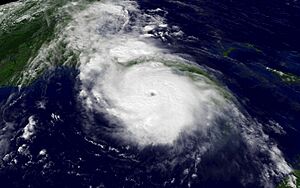Rapid deepening facts for kids
A rapid deepening happens when a tropical cyclone, like a hurricane or typhoon, gets much stronger very quickly. This means the air pressure at its center drops a lot in a short time. The National Weather Service says it's "rapid deepening" if the pressure falls by 42 millibars or more in less than 24 hours. But generally, this term is used for any storm that intensifies very fast.

Contents
What is Rapid Deepening?
Rapid deepening is a quick drop in the central air pressure of a tropical cyclone. Think of it like a vacuum cleaner. The lower the pressure in the center, the stronger the storm pulls air in. This makes the winds spin faster and the storm more powerful. It's a sign that a storm is becoming very dangerous.
How Does a Storm Rapidly Deepen?
For a storm to rapidly deepen, several things need to be just right.
- Warm Ocean Water: Tropical cyclones get their energy from warm ocean water. The water needs to be at least 26.5 degrees Celsius (80 degrees Fahrenheit) and deep enough. This provides lots of moisture and heat.
- Low Wind Shear: Wind shear is when winds blow at different speeds or directions at different heights. High wind shear can tear a storm apart. Low wind shear lets the storm grow tall and organized.
- Moist Air: The air around the storm needs to be very humid. Dry air can weaken a storm by making it less efficient.
- Good Outflow: A strong storm needs to vent air from its top. This "outflow" acts like an exhaust system, allowing more warm, moist air to rise from below.
The Eyewall Replacement Cycle
Sometimes, a storm can go through an "eyewall replacement cycle." This is when a new, larger eyewall forms around the original one. The old eyewall then collapses. During this process, the storm might weaken temporarily. But once the new eyewall takes over, the storm can often rapidly deepen again, becoming even stronger and larger.
Why is Rapid Deepening Important?
Rapid deepening is a big concern for people living near coastlines.
- Stronger Winds: When a storm rapidly deepens, its winds become much more powerful. This can cause more damage to buildings and trees.
- Higher Storm Surge: Stronger storms push more water towards the coast. This creates a dangerous storm surge, which is often the deadliest part of a hurricane.
- Less Warning Time: Because the strengthening happens so fast, people have less time to prepare or evacuate. This makes it harder for emergency services to keep everyone safe.
- Unpredictable Paths: Very strong storms can sometimes change direction more suddenly. This makes forecasting their path harder for meteorologists.
Forecasting Challenges
Predicting rapid deepening is one of the hardest jobs for weather forecasters. Even with advanced technology, it's tough to know exactly when and where a storm will suddenly intensify. Scientists are always working to improve their models and understanding of these powerful weather events. This helps give communities more time to get ready.
See also
 In Spanish: Rápida intensificación para niños
In Spanish: Rápida intensificación para niños

